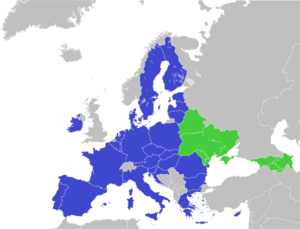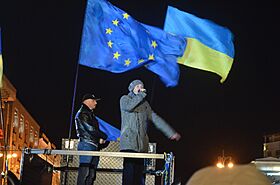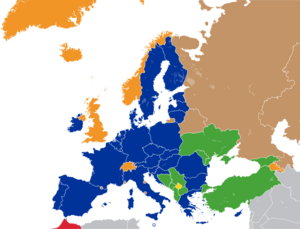Ukraine–European Union relations facts for kids
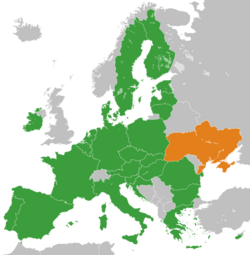 |
|
European Union |
Ukraine |
|---|---|
| Diplomatic Mission | |
| European Union Delegation, Kyiv | Mission of Ukraine, Brussels |
The European Union (EU) and Ukraine have a close relationship. This partnership is built around the Ukraine–European Union Association Agreement and a special trade deal called the Deep and Comprehensive Free Trade Area (DCFTA). Ukraine is an important partner in the Eastern Partnership and the European Neighbourhood Policy (ENP).
Their relationship has grown stronger over time. It goes beyond simple cooperation, moving towards economic integration and deeper political teamwork. On June 23, 2022, the European Council officially made Ukraine a candidate country to join the European Union.
The Association Agreement was first planned in 2012. However, on November 21, 2013, Ukraine's government, led by President Viktor Yanukovych, paused preparations to sign it. This decision sparked the pro-EU Euromaidan protests. These protests led to Yanukovych and his government being removed from power in February 2014.
The political part of the Association Agreement was signed on March 21, 2014, by Prime Minister Arseniy Yatsenyuk. The EU also froze money belonging to some Russians and Ukrainians suspected of corruption and gave financial help to Ukraine. The economic part of the agreement was signed on June 27, 2014, by the new president, Petro Poroshenko.
On January 1, 2016, Ukraine officially joined the DCFTA with the EU. Ukrainian citizens gained visa-free travel to the Schengen Area (a zone of many European countries) on June 11, 2017. This allowed them to visit for up to 90 days within any 180-day period. The Association Agreement fully started on September 1, 2017.
On February 21, 2019, Ukraine's Constitution of Ukraine was changed. It now clearly states that Ukraine's goal is to become a member of the European Union and NATO. On February 28, 2022, during the 2022 Russian invasion of Ukraine, Ukrainian President Volodymyr Zelenskyy officially applied for EU membership. Leaders from Poland, Slovenia, and the Czech Republic visited Kyiv to show their support during the invasion.
Ukraine shares borders with four EU countries: Hungary, Poland, Slovakia, and Romania. These borders stretch for about 2,235 kilometers (1,389 miles). There are 33 border crossings for roads, railways, ferries, and even walking or cycling paths.
On December 14, 2023, the European Council agreed to start official talks for Ukraine to join the EU.
Contents
How Ukraine and the EU Became Closer

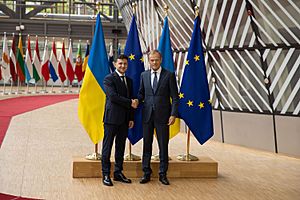
Early Steps Towards Europe
Ukraine first showed interest in joining the European Union in 1993. Its government said that becoming part of the EU was a main goal. However, not much happened at first. Ukraine also had to consider its strong trade ties with Russia, especially for natural gas.
Formal talks between the EU and Ukraine began in 1994. They signed a Partnership and Cooperation Agreement (PCA). This agreement focused on economic and social issues. It also highlighted the need for government reforms and protecting freedoms like free press. The first EU–Ukraine summit happened in September 1997 in Kyiv.
The 1994 agreement officially started in 1998 and ended in 2008. In 1998, EU–Ukraine relations were called a "strategic and unique partnership." Ukraine then said it wanted to become an associate member of the EU. But these early meetings didn't lead to big changes. Leaders mainly discussed Ukraine's economy, human rights, and issues related to the Chernobyl nuclear power plant.
In 2002, an EU official, Günter Verheugen, said Ukraine might join the EU in 10 to 20 years. Ukraine's President Leonid Kuchma then stated that Ukraine would meet all EU requirements by 2007–2011.
After the Orange Revolution

The Orange Revolution in late 2004 made Ukraine's chances of joining the EU look better. The new leader, Viktor Yushchenko, wanted stronger ties with the EU. He outlined a plan: for the EU to recognize Ukraine as a market economy, for Ukraine to join the World Trade Organization, then become an associate EU member, and finally, a full member.
In January 2005, the European Parliament voted strongly to build closer ties with Ukraine, seeing a possibility for future EU membership. The European Commission said that future membership was not ruled out. Many EU leaders supported closer economic links.
In October 2005, European Commission President José Manuel Barroso said Ukraine's future was "in" the EU. However, in November 2005, the European Commission suggested that adding more countries (like Croatia) might make it harder for Ukraine, Armenia, Belarus, Georgia, and Moldova to join.
Talks for Closer Ties
In March 2007, the EU and Ukraine began talks for a new "wider agreement." This agreement aimed to create a legal framework for closer economic cooperation and better political discussions. They also agreed to start separate talks about setting up a free trade area.
A "Joint EU–Ukraine Action Plan" was approved on February 21, 2005. This plan provided a detailed framework for Ukraine and the EU to work together on reforms.
Talks on a free trade agreement began on February 18, 2008. Portugal publicly supported Ukraine's EU membership in July 2008.
Visa-Free Travel Discussions
In October 2008, the EU and Ukrainian officials met to discuss visa-free travel. Ukraine wanted a clear plan for lifting visa requirements. The EU wanted Ukraine to improve its border control and migration policies.
Ukrainian President Yushchenko noted that some EU embassies asked Ukrainians for extra documents not required by agreements. This made getting visas difficult and expensive.
In June 2009, Germany's Free Democratic Party became the first major German political party to openly state that Ukraine had a right to EU membership in the long term.
A new tool, the "EU-Ukraine Association Agenda," was adopted on June 16, 2009.
Eastern Partnership Program
Ukraine is one of six former Soviet nations invited to work with the EU under the new Eastern Partnership program. Ukraine, however, felt this initiative didn't add much to their existing talks with the EU. Ukraine already had negotiations for new political and free-trade agreements.
Ukraine believes the Eastern Partnership should help it achieve its main foreign policy goal: integration with the EU. However, the Eastern Partnership documents do not specifically mention political and economic integration or lifting visas as priorities.
Despite this, Ukraine has shown enthusiasm for the project. Ukraine's deputy premier, Hryhoriy Nemyria, said it helps modernize the country. He welcomed the policy because it uses similar tools as those for countries that are candidates to join the EU.
Under the Eastern Partnership, Poland and Ukraine made a new agreement. It replaced visas with simpler permits for Ukrainians living near the border. About 1.5 million people could benefit from this, starting July 1, 2009.
Yanukovych's Presidency
In May 2010, President Viktor Yanukovych promised to pass laws needed for a free trade zone with the EU. He hoped visas would be abolished and a free trade zone created by March 2011.
His government continued to pursue EU integration. Both Prime Minister Mykola Azarov and Foreign Minister Kostyantyn Gryshchenko stated that joining Europe was Ukraine's top priority.
On November 22, 2010, the EU and Ukraine agreed on a plan for visa-free travel. This plan required Ukraine to make big improvements in border control and migration policies.
The Association Agreement
The EU Association Agreement (AA) was first agreed upon in March 2012. However, the EU had concerns about the treatment of former Prime Minister Yulia Tymoshenko, who was in prison. EU leaders saw her trial as politically motivated.
EU officials boycotted the UEFA Euro 2012 soccer championship in Ukraine because of these concerns. EU leaders suggested the AA would not be approved unless Ukraine improved its democracy and rule of law. This included releasing Tymoshenko and Yuriy Lutsenko.
On December 10, 2012, the EU Foreign Affairs Council said it was ready to sign the AA. But Ukraine needed to show clear progress in electoral, judicial, and constitutional reforms. These reforms had to meet international standards.
Ukraine's Ambassador to the EU, Kostiantyn Yelisieiev, initially rejected any conditions for signing the AA. However, on February 22, 2013, Ukraine's parliament (the Verkhovna Rada) voted to implement the EU's recommendations.
On February 25, 2013, President Yanukovych said Ukraine would "do its best" to meet the EU's requirements. At the same time, he was also talking with Russia about joining their customs union. However, European Commission President José Manuel Barroso made it clear that a country could not be part of both a customs union and a deep free-trade area with the EU.
Ukraine created a "Plan on Priority Measures for European Integration of Ukraine for 2013." This plan aimed to prepare Ukraine for European integration. Its successful completion was a condition for signing the AA, planned for November 29, 2013.
In March 2013, EU Commissioner Stefan Fuele warned that the agreements could be dropped if reforms weren't made quickly. However, Ukraine's Foreign Ministry remained hopeful. On April 7, 2013, President Yanukovych freed Lutsenko from prison.
On September 18, the Ukrainian government approved the draft association agreement. On September 25, the Chairman of the Verkhovna Rada, Volodymyr Vasylyovych Rybak, was confident that parliament would pass all necessary laws.
Agreement Signing Suspended
On November 21, 2013, the Verkhovna Rada failed to pass laws that would allow former Prime Minister Yulia Tymoshenko to receive medical treatment abroad. This was a key EU demand. The same day, a Ukrainian government order stopped preparations for signing the association agreement. Instead, it suggested a three-way trade commission with the EU and Russia. This decision was made to "ensure the national security of Ukraine" and consider trade issues with Russia.
This suspension of the agreement led to the Euromaidan protests. These protests eventually led to the overthrow of Viktor Yanukovych and his government.
Relations After Suspension
On December 2, 2013, European Commission President José Manuel Barroso agreed to meet with Ukrainian officials. He said there would be no new negotiations on the agreement. Ukraine announced plans to sign a "roadmap" with the EU. However, on December 15, Commissioner Fuele said Ukraine's negotiating position was unrealistic and suspended further talks.
On December 17, Ukraine signed a treaty with Russia. Russia agreed to buy $15 billion of Ukrainian bonds and reduce the price of natural gas. Russian President Vladimir Putin said they did not discuss Ukraine joining Russia's customs union. EU officials later stated they were still ready to sign the AA when Ukraine was ready.
On January 15, 2014, Ukrainian Prime Minister Mykola Azarov gave his government two months to create a plan for implementing the Association Agreement.
Euromaidan and Agreement Approval
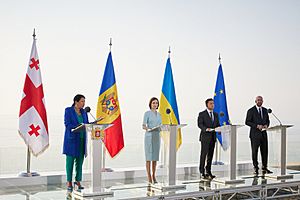
After the Revolution of Dignity in February 2014, Viktor Yanukovych and his government were removed. Russia then invaded Crimea, and the war in Donbas began. In March 2014, the EU condemned Russia's actions, calling them a "clear violation of Ukrainian sovereignty." The EU also froze assets of Russians and Ukrainians linked to the unrest.
The political part of the Association Agreement was signed on March 21, 2014, by Prime Minister Arseniy Yatsenyuk. The parts about free trade were delayed until after the May elections. The EU temporarily removed customs duties for Ukrainian exports in April 2014 and promised financial aid.
After the election, new President Petro Poroshenko and the EU signed the economic part of the Association Agreement on June 27, 2014. President Poroshenko called it Ukraine's "first but most decisive step" towards EU membership. He also aimed for Ukraine to apply for EU membership by 2020. On September 16, 2014, the Verkhovna Rada approved the agreement, and President Poroshenko signed it.
The same year, the EU and Ukraine created the EU Advisory Mission Ukraine (EUAM Ukraine). This mission helps Ukraine reform its civilian security sector. EUAM Ukraine advises and supports Ukrainian law enforcement and rule of law agencies. Its goal is to make these agencies more efficient, transparent, and trusted by the public.
The 17th EU-Ukraine summit took place on April 27, 2015, in Kyiv. In May 2015, the EU agreed to a €1.8 billion loan for Ukraine. On January 1, 2016, the Deep and Comprehensive Free Trade Area between Ukraine and the EU officially started.
By April 2016, all EU member states except the Netherlands had approved the Association Agreement. The Netherlands held a referendum, which rejected the agreement. To address concerns, the EU leaders agreed in December 2016 on interpretations of the agreement. These stated that the agreement did not promise Ukraine EU membership, security guarantees, military or financial aid, or free movement within the EU. The Dutch parliament then approved the agreement in 2017.
On October 12, 2021, Ukraine and the EU signed an agreement on the European Common Aviation Area. This agreement helps make air travel between Ukraine and the EU easier.
On April 27, 2022, the EU Commission suggested temporarily removing all tariffs on imports from Ukraine. This was to help Ukrainian industries during the Russian invasion.
On May 29, 2022, Ukraine launched a campaign called "Embrace Ukraine. Strengthen the Union." This campaign aimed to support Ukraine's path to becoming an EU candidate.
Financial Support from the EU
The EU has provided financial assistance to Ukraine for many years. From 2000 to 2006, this help came through the TACIS program. This program supported countries moving towards market economies.
From 2007 to 2013, the European Neighbourhood and Partnership Instrument (ENPI) replaced TACIS funds for Ukraine. By May 2014, the EU had given Ukraine 11 billion Euros in aid.
Ukraine also receives help from other EU programs. These include the Instrument for Stability, which helps with crises and cross-border challenges like nuclear safety and fighting crime. There is also the Macro-Financial Assistance program.
In 2023, the European Investment Bank (EIB) created the EU for Ukraine Fund. This fund helps Ukraine with urgent needs. It focuses on fixing municipal buildings, improving public services, and supporting businesses. EU countries have promised about €400 million to this fund.
The EU has also committed a €50 billion financial aid package for Ukraine. This package will run from 2024 to 2027. By 2024, over 300 hospitals, social housing facilities, schools, and kindergartens have been renovated in 150 cities thanks to this support.
Ukraine's WTO Membership
Since 2009, Ukraine has been a member of the World Trade Organization (WTO). This means that economic relations between the EU and Ukraine must follow WTO rules. The EU believes that WTO membership helps Ukraine's economic reforms. By joining the WTO, Ukraine gets secure access to markets worldwide. It also commits to a stable trade and investment environment, which attracts more business.
Important Meetings Between the EU and Ukraine
EU-Ukraine Summits
- 1st EU-Ukraine Summit: September 1997 in Kyiv
- 2nd EU-Ukraine Summit: October 1998 in Vienna
- 3rd EU-Ukraine Summit: July 1999
- 4th EU-Ukraine Summit: September 2000
- 5th EU-Ukraine Summit: September 2001 in Yalta
- 6th EU-Ukraine Summit: July 2002 in Copenhagen
- 7th EU-Ukraine Summit: October 2003 in Yalta
- 8th EU-Ukraine Summit: July 2004 in The Hague
- 9th EU-Ukraine Summit: December 2005 in Kyiv
- 10th EU-Ukraine Summit: October 2006 in Helsinki
- 11th EU-Ukraine Summit: September 2007 in Kyiv
- 12th EU-Ukraine Summit: September 2008 in Paris
- 13th EU-Ukraine Summit: December 2009
- 14th EU-Ukraine Summit: November 2010 in Brussels
- 15th EU-Ukraine Summit: December 2011
- 16th EU-Ukraine Summit: February 25, 2013, in Brussels
- 17th EU-Ukraine Summit: April 27, 2015, in Kyiv
- 18th EU-Ukraine Summit: November 24, 2016, in Brussels
- 19th EU-Ukraine Summit: July 12–13, 2017, in Kyiv
- 20th EU-Ukraine Summit: July 9, 2018, in Brussels
- 21st EU-Ukraine Summit: July 8, 2019, in Kyiv
- 22nd EU-Ukraine Summit: October 6, 2020, in Brussels
- 23rd EU-Ukraine Summit: October 12, 2021, in Kyiv
- 24th EU-Ukraine Summit: February 3, 2023, in Kyiv
Other EU Summits with Ukraine
- Eastern Partnership Summit in Prague in May 2009
- Eastern Partnership Summit in Warsaw in September 2011
- Eastern Partnership Summit in Vilnius in November 2013
- Eastern Partnership Summit in Riga in May 2015
- Eastern Partnership Summit in Brussels on November 24, 2017
Ukraine's Representatives to the EU
These are the people who have represented Ukraine in its dealings with the European Union:
- Volodymyr Vasylenko (1992–1995)
- Ihor Mityukov (1995–1997)
- Borys Hudyma (1997–2000)
- Roman Shpek (2000–2007)
- Andrii Veselovsky (2008–2010)
- Kostiantyn Yelisieiev (2010–2015)
- Liubov Nepop (interim, 2015–2016)
- Mykola Tochytskyi (2016–present)
Public Support for Ukraine Joining the EU
Many people in Ukraine support joining the European Union. A poll in November 2014 showed that most regions supported joining the EU. Only in Luhansk Oblast and Donetsk Oblast (the Donbas area) did people prefer joining the Eurasian Customs Union.
Traditionally, Western Ukraine has been more excited about EU membership than Eastern Ukraine. In July 2012 and May 2014, people in West, Central, and North Ukraine were the biggest supporters of EU membership. A June 2013 poll showed that 52% of Eastern Ukraine was in favor of joining the EU. However, a May 2014 poll found that in the three most eastern regions, 37% favored an alliance with Russia, 14% with the EU, and 49% preferred no alliance.
Younger citizens (aged 20-39) were the strongest supporters of joining the EU in 2010 and 2011. In the May 2014 poll, people aged 36-55 were the strongest supporters.
Ukraine's EU ambassador, Kostiantyn Yelisieiev, said in July 2011 that even wealthy business leaders and politicians from eastern Ukraine were pro-EU. He stated that any politician against European integration would lose political support.
A poll in February 2015 showed that 66.4% of Ukrainians would vote to join the EU. During the 2022 Russian invasion of Ukraine, support for joining the EU grew even higher. A poll in March 2022 found that 91% of Ukrainians supported joining the European Union.
| Support in Ukraine for European Union and Eurasian Customs Union or Eurasian Economic Union membership | ||||||||||||||||||||||||||||||||||||||||||||||||||||||||||||||||||||||||||||||||||||||||||||||||||||||||||||||||||||||||||||||||||||||||||||||||||||||||||||||||||||||||||||||||||||||||
|---|---|---|---|---|---|---|---|---|---|---|---|---|---|---|---|---|---|---|---|---|---|---|---|---|---|---|---|---|---|---|---|---|---|---|---|---|---|---|---|---|---|---|---|---|---|---|---|---|---|---|---|---|---|---|---|---|---|---|---|---|---|---|---|---|---|---|---|---|---|---|---|---|---|---|---|---|---|---|---|---|---|---|---|---|---|---|---|---|---|---|---|---|---|---|---|---|---|---|---|---|---|---|---|---|---|---|---|---|---|---|---|---|---|---|---|---|---|---|---|---|---|---|---|---|---|---|---|---|---|---|---|---|---|---|---|---|---|---|---|---|---|---|---|---|---|---|---|---|---|---|---|---|---|---|---|---|---|---|---|---|---|---|---|---|---|---|---|---|---|---|---|---|---|---|---|---|---|---|---|---|---|---|---|---|
|
||||||||||||||||||||||||||||||||||||||||||||||||||||||||||||||||||||||||||||||||||||||||||||||||||||||||||||||||||||||||||||||||||||||||||||||||||||||||||||||||||||||||||||||||||||||||
|
||||||||||||||||||||||||||||||||||||||||||||||||||||||||||||||||||||||||||||||||||||||||||||||||||||||||||||||||||||||||||||||||||||||||||||||||||||||||||||||||||||||||||||||||||||||||
|
||||||||||||||||||||||||||||||||||||||||||||||||||||||||||||||||||||||||||||||||||||||||||||||||||||||||||||||||||||||||||||||||||||||||||||||||||||||||||||||||||||||||||||||||||||||||
Ukraine's Path to EU Membership

Early Discussions on Membership
On January 12, 2002, the European Parliament noted that Ukraine might join the EU in the future. To join, a country must meet the Copenhagen Criteria. These are political and economic conditions, including having a democratic government, respecting the rule of law, and protecting human rights. All current EU members and the European Parliament must agree to any new member.
In 2005, Ukraine's President Viktor Yushchenko declared that full EU membership was a strategic goal. On January 13, 2005, the European Parliament voted almost unanimously to move closer to Ukraine for membership. President Yushchenko then said he intended to apply for membership "in the near future."
Many EU leaders supported closer ties. Polish Foreign Minister Adam Rotfeld said Poland would always support Ukraine's European integration. In October 2005, European Commission President Jose Manuel Barroso said "Ukraine's future is in the EU." However, the European Commission also suggested that adding other countries might make it harder for Ukraine to join.
2007-2014: Steps and Setbacks
In March 2007, Ukraine was offered a Free Trade Agreement with the EU. This proposal did not include specific plans for Ukraine to join the EU soon. Some Western European politicians felt the EU was "tired of enlargement." When the "Enhanced Agreement" between Ukraine and the EU was being finalized in March 2007, any mention of Ukraine's future membership was removed. This was mainly due to France's position.
However, the Eastern Partnership policy states that Ukraine can become an EU member. On February 27, 2014, the European Parliament passed a resolution. It recognized Ukraine's right to apply for EU membership if it followed democratic principles and respected human rights. On June 27, 2014, European Commission President Jose Manuel Barroso said the Association Agreement was the start of Ukraine's journey to join the EU.
2014-2022: Continued Efforts
In March 2016, European Commission President Jean-Claude Juncker said it would take at least 20–25 years for Ukraine to join the EU and NATO. In June 2018, Ukraine's President Petro Poroshenko said he expected Ukraine to join the EU and NATO by 2030.
In June 2019, Ukraine, Poland, and Lithuania signed a document. It suggested 2025 and 2027 as possible times for Ukraine to join the EU. In 2027, when Lithuania leads the EU for the second time, Ukraine's issue would be a main topic.
On July 23, 2020, Poland, Lithuania, and Ukraine created the Lublin Triangle. This group aims to support Ukraine's integration into the EU and NATO.
In February 2021, Armin Laschet, a German political leader, supported the idea of the EU growing and giving Ukraine a "European perspective." He said that while Ukraine's membership was not immediate, it would "inevitably arise in the future."
Many experts believe that with changing relations between Russia and the EU, Ukraine has a chance to join the EU. However, some, like Pavlo Klimkin, noted that Ukraine still needed to meet many EU criteria. These include having a strong democracy, rule of law, and a full market economy.
In February 2021, the European Parliament published a report on Ukraine's progress with the Association Agreement. It highlighted successes and challenges. While the EU was not ready to officially discuss Ukraine's membership, it recognized Ukraine's European future. In 2021, Ukraine planned to formally apply for EU membership in 2024, hoping to join in the 2030s.
2022-Present: Accelerated Path


After the 2022 Russian invasion of Ukraine, there were strong calls to start the formal process for Ukraine to join the EU. Ukraine repeated its desire to become a member. European Commission President Ursula von der Leyen stated that Ukraine belongs in the European Union. Slovak Prime Minister Eduard Heger supported a faster process.
On February 28, Ukraine officially applied for membership. President Volodymyr Zelenskyy asked for immediate admission under a special procedure due to the ongoing crisis. Eight EU states signed a letter supporting a faster process for Ukraine. On March 1, Hungary also supported this.
On March 1, 2022, the European Parliament voted to recommend Ukraine become an official "candidate" for EU membership. The vote was 637 in favor, 13 against, and 26 abstentions. However, on March 2, Spanish Foreign Minister José Manuel Albares reminded everyone that joining the EU is a serious process. A country must meet certain social, political, and economic standards.
On March 7, the EU said it would formally review Ukraine's application. On April 8, European Commission President Ursula von der Leyen visited Kyiv and gave President Zelenskyy a questionnaire for membership. On April 18, Ukraine completed the questionnaire. On May 24, the EU Council adopted a rule to temporarily remove all tariffs on imports from Ukraine. This helps Ukrainian industries during the conflict.

On June 17, 2022, the EU Commission officially recommended granting Ukraine EU candidate status. On June 23, 2022, the European Council granted Ukraine the status of a candidate for accession to the European Union. In January 2023, Ukraine's prime minister said the country would join the EU "within the next two years," though this was seen as very optimistic by many in the EU.

On May 8, 2023, Ukraine's President issued a decree to celebrate Europe Day on May 9, just like EU member states. This decision shows Ukraine's European identity.
In October 2023, former European Commission President Jean Claude Juncker said Ukraine was "massively corrupt" at all levels. He believed Ukraine joining the EU would not be good for either side. This view was different from the current EU Commission President Ursula von der Leyen, who wanted to start membership talks for Ukraine. Many see Ukraine's EU membership as a key factor in winning the conflict with Russia, as the country relies on European support.
On November 8, 2023, the European Commission recommended starting accession talks with Ukraine and Moldova. On December 14, 2023, the European Council agreed to open these talks. On June 21, 2024, the European Union agreed to officially start membership negotiations with Ukraine. These negotiations began on June 25, 2024, at the same time as those with Moldova.
Ukraine's Relations with EU Countries
See also
- Accession of Ukraine to the European Union
- Eastern Partnership
- European Political Community
- Euronest Parliamentary Assembly
- Poland–Ukraine relations
- Ukraine–NATO relations
- 2022 Russian invasion of Ukraine


